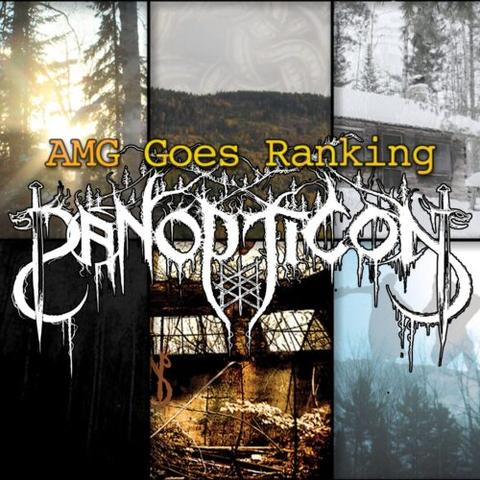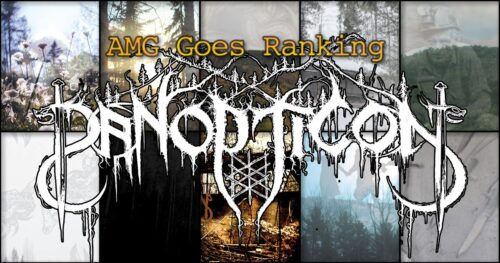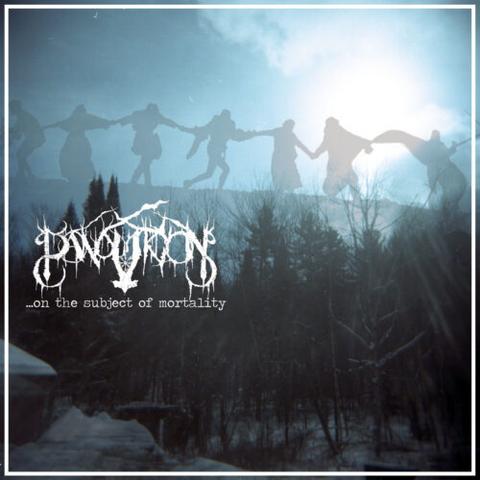AMG Goes Ranking – Panopticon
By Thus Spoke
Whether they “invented” it or not, Panopticon’s blend of bluegrass and black metal is distinctive in a way few superficially similar acts can match. From the very start, there was something special, and while the sound grew more refined, its core never changed—there was always an immense sense of drama, emotional intensity, and an unpretentious, honest heart that you could feel whether progenitor Austin Lunn was shrieking in fury or crooning softly.
Panopticon sits apart not only from other USBM acts, but from black metal acts in general. In many senses, the project functions as a kind of antithesis or a subversion of several unfortunate black metal stereotypes. Whereas the “trve” image of the genre is one of aggression and hatred, often to the point of edginess, Panopticon embodies something a lot closer to love, inverting the trope of isolation and darkness on its head in an overwhelming message of solidarity. The rebelliousness embodied by a particularly black metal fondness for (real or affected) devil-worship manifests instead through authentic and peaceful anarchist philosophy. “Nature worship” is delivered through environmentalism rather than religiosity. Though a solo act, there is little, if any, lyrical space devoted to navel-gazing, with the emphasis again being on common human experience, and the natural world we all share. The consistent prominence of samples provides yet another window into the spirit that lies behind every record, as they show glimpses of political fear-mongering and the dehumanization of “undesirable” groups, giving a voice to the fight for workers’ rights, environmental protection, righteous anger, and yet also, hope for the future.
And so, of all the words I associate with Panopticon, “empathy” is near the top. It’s probably the reason that I can’t get through most of these albums without crying. That incredibly human aspect to the music also makes the impact of individual albums very personal, having spoken to my fellow rankers and read their submissions, this is quite evident. Even where we align, our reasons often don’t.
Before we begin, I want to shout out Mystikus Hugebeard in particular. Were it not for him and his orb of infinite wisdom suggesting it in the first place, I would not have dragged myself out of a quiet hiatus and pulled together this piece at all. I feel privileged to be able to write this introduction, given my relative lack of seniority compared to Panopticon’s resident official reviewer, El Cuervo. I guess this shows you where keenness (and a good suggestion) can get you. I hope you’re all ready for a long and lascivious tongue-bathing of one of black metal’s most stoically and understatedly iconic artists.
The Rankings
Thus Spoke
#10. On the Subject of Mortality (2010) – Every Panopticon album has a ‘moment’ for me where I am bowled over by the heady combination of jaw-dropping musical composition and emotional intensity, i.e, a bit that makes me cry. Except for this one. I do love some of these songs in isolation (“Living Eulogy,” “To Make an Idol of Our Fear and Call it God”), but overall, there’s an intangible absence of force, a twist of a knife or sigh of despair, or heart-stopping climax, that relegates Mortality to its unfortunate position. Perhaps the lukewarm vibes are a result of Mortality’s status as a kind of compilation of past tracks initially released in splits and singles, and there’s a subconscious lack (whether on my part or Panopticon’s) of driving central purpose and weight. I hate to put any Panopticon record at the bottom of anything, but something has to be here.
#9. Collapse (2009) – While still a very cool album, Collapse leaves me oddly cold. The trajectory falters a little as it sways between the debut’s vehement rawness, a floatier, more post-black sound, and passages of Appalachian folk which would come to define later Panopticon. Sometimes, they all converge brilliantly (“The Death of Baldr and the Coming War,” “Merkstave,” “Beginning of the End”), and even when the separation is more stark (“Aptrgangr,” “Idavoll,”) the music doesn’t lack coherence, just refinement. Collapse mixes in the new with the old in a way that both evolves Panopticon’s sound and keeps things consistently unique. Its grip is, nonetheless, uneven, with highlights in “The Death…,” “Merkstave,” and “The Beginning of the End” punctuated by lesser movements. As a symptom of a developing style, this is forgivable, especially given where things went.
#8. Autumn Eternal (2015) – Look, I’m sorry; I know this is a fan favorite. I’ve just never seen what so many seem to see in Autumn Eternal when they count it among Panopticon’s best. Yes, it’s beautiful (“Pale Ghosts”) and can be epic, but so are all Panopticon albums, and relative to its sisters, Autumn Eternal’s swooping gestures and delicate caresses feel like a dilution of Panopticon traits, with much less magic than on many other outings. There’s comparatively little fire in the blazing black metal of the charges, and the melodies are simply less interesting (“Oaks Ablaze” and “A Superior Lament”). Even when the execution is—as is to be expected—superb (“Autumn Eternal,” “Pale Ghosts”), I am never as enamored as I am when I listen to other preferred Panopticon moments. This is also the record where I enjoy the folkier touches the least (except for Collapse). And though it’s far from Panopticon’s longest, Autumn Eternal almost drags.
#7. Social Disservices (2011) – Panopticon records have a habit of hitting pretty hard, but Social Disservices hits hard in a very particular way. In addition to its musical strikingness as the smoothest blend yet of atmospheric black metal, it’s also conceptually striking in the form of a brutal gut-punch at the moment you first notice what’s going on. You don’t even need to read the lyrics to experience this epiphany, just the track list. “Resident” becomes “Client,” who becomes “Subject,” and finally “Patient,” adumbrating the insidious progression of control and objectification of the individual by systems of power. As if its biting words and magnificently moving melodies (“Client,” “Patient”) weren’t enough, the distressing samples of screaming babies (“Client”) and overlapping voices of anger and despair (“Subject”) leave absolutely no escape. This effect is so powerful that it proves slightly harmful for this record’s ranking, as there is little to no peace or calm from the onslaught until “Patient”‘s closing act. But every time I do return, I remember it’s a brilliant atmo-black record, and curse my forgetfulness.
#6. Panopticon (2008). Woe to those who dismiss the debut. Powerfully intense in itself, it further blows my mind by how much of the later Panopticon is audible in it. Already so dynamic, and so emotionally and politically-charged, with Lunn’s anti-authoritarian anarchist philosophy (“Flag Burner, Torch Bearer,” “…Speaking…,” “Emma’s Song”) on full display.1 A passionate series of epic-length, sample-splicing blackened storms, prefiguring Panopticon idiosyncrasies to come. Fluent, dynamic drumming that eschews the monotone blastbeat and gives away Lunn’s beginnings as a drummer; dramatic, triumphant rhythmic riffing;2 the touch of atmosphere in resonant chords and weeping tremolos. Already, the emotional core reaches beyond the fury of the angriest moments (“I, Hedonist,” “Emma’s Song”), with “…Speaking…” delivering potent poignancy in stirring, melancholic atmoblack that builds to a fever of pathos. Yes, it needs a trim, and it’s a little rough around the edges, but as the birth of Panopticon, things could hardly have gone better.
#5. The Rime of Memory (2023) – Given the unadulterated praise I heaped upon The Rime of Memory, you’d be forgiven for assuming that this would have ended up higher. But the ridiculous calibre of this band’s discography means that from here on, all albums are at least Excellent, and this one’s being here is more a case of others’ strengths. It’s Panopticon at their most consistently beautiful in the engrossing part folk, part gaze, part blistering black metal way that no subgenre peer can match (“Cedar Skeletons,” “The Blue Against the White”). It’s a paragon of marathon-length black metal songwriting, where the immersion just doesn’t break and the musical and emotional builds and releases are earned, and affecting on a huge scale (“Winter’s Ghost,” “Cedar Skeletons,” “Enduring the Snow Drought”). Like its predecessor …And Again Into the Light, the more prominent use of cello and violin works to further pull on the heartstrings by augmenting melodies with weeping, drawling warmth and sadness. This is how you do atmoblack; or at least, this is how Panopticon is doing it currently, and it’s absolutely wonderful.
#4. Roads to the North (2014) – I consider Roads to the North to be Panopticon’s most Panopticon-sounding album of all. Unlike Autumn Eternal, which analogously distills the core musical aura and is divided into more numerous, shorter songs, Roads to the North pulls no punches in any dimension, never sacrificing the authenticity of bluegrass or the consuming force of black metal. The seamless, and emotionally stirring flow of distinct but univocal movements—especially the “Long Road” trilogy and its gorgeous final part—is nothing short of masterful. And the riffs here are fantastic (“The Echoes of a Disharmonic Evensong,” “In Silence,” “Chase the Grain”); not only vivacious and memorable but so effortlessly matching the spirit of the folk that tells the story of the record in tandem both separately, measuredly, perfectly (“Norwegian Nights”), and with clever, stirring integration (“Where Mountains Pierce the Sky,” “The Sigh of Summer”). There is precious little barring Roads to the North’s entry into my top 3; maybe with more time, it’ll end up there.
#3. Kentucky (2012). When I first heard Kentucky, I didn’t love it. This was probably a knee-jerk reaction to the tin whistle and the uptempo country vibe of the bluegrass tracks. But the characteristically stirring black metal, dramatically rent with thundering drums, gentler folk (“Black Waters,” “Kentucky”), and testimony, always took me. Soon the tin whistle’s dissonance gained a striking thrill, and the rousing, commiserating calls of “Come All Ye Coal Miners” and “Which Side are You On” claimed their rightful position as vital chapters in the tale: the moving story of the Kentucky coal mining industry that ravaged the mountains and ruined lives through abuse and corruption. Heartening, bittersweet hope (“Black Soot and Red Blood”) with uplifting scales and inexorable, battering lows. Huge drama befitting the Appalachian mountains themselves (“Killing the Giants as they Sleep”) with cascading guitar lines, and infinite atmospheres surrounding the stunned sorrow of returning to a devastated landscape. I am unfailingly moved, and can understand why this is #1 for so many, even though it isn’t mine.3
#2. The Scars of Man on the Once Nameless Wilderness (2018) – Scars’ dualistic nature—so often bearing the brunt of criticism as listeners disown either part—is central to its brilliance. With Part 1 centring on the relationship between mankind and nature, Part 2 zooms in closer on the people; the macro and the micro-relations central to the creation and deepening of the Scars. The former epitomizes its focus with wilder black metal that could be favorably compared to Mare Cognitum at times, complete with some of Panopticon’s best riffs (“Blåtimen,” “Sheep in Wolves’ Clothing”) and most dramatically beautiful melodies (“Snow-Burdened Branches”).4 The hinted mournfulness is felt more keenly in Part 2, whose acoustic stylings lay bare the disenfranchisement and loneliness latent under the snow. Panopticon’s best bluegrass lies here, and particularly over the last few weeks I’ve frequently found myself singing most of this album to myself (“The Moss Beneath the Snow,” “Four Walls of Bone,” “A Cross Abandoned.”) A younger, more ignorant me would have scorned my genuine love for the ‘country’-ness of this. Maturing is recognizing that the love for this spectacular double album is justified.
#1. …And Again into the Light (2020). This is not just Panopticon’s best album, but one of my favorite albums of all time. The deeply personal nature is underscored by the unpublished lyrics, and the spellbinding blend of force and delicacy here is perfected. The bluegrass is supernaturally peaceful (“…And Again into the Light,” “Her Golden Laughter Echoes”), passing into black metal with the most grace of any Panopticon example. And when it melts into gaze, in “The Embers at Dawn,” it’s so softly sad it breaks my heart. The intertwining of dizzying violins amidst the tumbling percussion in an avalanche of emotion, only an emphatic crash away from syrupy atmosphere (“Dead Loons,” “Rope Burn Exist”), is a natural and simple perfection of Panopticon’s characteristically ardent style. The heaviness which peaks in devastating “Moth Eaten Soul” is matched in goosebump-inducing ability only by “The Embers At Dawn” and the triumphant close of “Know Hope.” Every track is a monolith, yet they blend into one another so seamlessly, through exquisitely-pitched pauses of ringing chords and bird calls, that I’m practically holding my breath in awe the entire time. And if the incredible music weren’t enough in its own right, the album’s thesis of hope and light for those who feel alone, overwhelmed, and in the dark strengthens it beyond an indubitably iconic status. It’s a masterpiece that even Panopticon may struggle ever to surpass.
El Cuervo
Consigned to History
#10 Panopticon – Had the Panopticon debut arrived a decade earlier, it might have been heralded as something more than it is. Though a clattering, chaotic slice of Norwegian-style black metal, its lengthy compositions and shreddy production give it an edge that many 90s bands didn’t have. But Panopticon features almost none of the qualities that would go on to define the band. This type of music will always have an old-school charm, but in the context of Austin Lunn’s entire discography, it’s an unremarkable introduction given how much his sound would change. If you desperately desire to hear more black metal, it’ll do that job but less well than many of its influences. It’s hard to conceive this record as anything other than a formative learning experience, and it’s far from essential.
#9 Collapse – Lunn’s music frequently boils with righteous, politically-charged indignation, but Collapse is his angriest work. He channels his fury through scything leads and powerful roars, not stepping off the black metal pedal for the first ten minutes of “The Death of Baldr and the Coming War.” But the abrupt side-step into twee bluegrass for the subsequent ten minutes of the record represented a tide-change in black metal, transitioning Lunn from a quasi-Norwegian into someone distinctly more American. The songwriting and melodies here are far from Panopticon’s artistic peak. Both the black metal and folksy passages are fairly rote and lack real cohesion, as one starts and the other ends without proper transitions. But it’s hard to imagine that the band would have hit the heights that it has without the progression audible on Collapse.
Assured Steps
#8 …on the Subject of Mortality – Though Panopticon is best known for its fusion of black metal with bluegrass (blackgrass?), there are also post-rock influences in the pot. These first appear on …on the Subject of Mortality, which marks the beginning of progression away from simple black metal towards subtler black metal. The engaging layers of guitars and bold melodic lines characterize this record compared with its predecessors, even if Lunn’s vocals were still in their rougher, blacker era. And though his prior work had the fire and fury you would expect of a young black metal artist, …on the Subject of Mortality features the dramatic flair that he now evidently enjoys. This partly flows from the music that’s more dynamic – switching from blackened blasting to bold shredding to shimmering walls to lilting interludes – but also an emotive shift from pure anger to a broader spectrum. …on the Subject of Mortality was a confident step towards musical maturity.
#7 The Rime of Memory – The Rime of Memory is basically a good record. Panopticon hasn’t made a record that’s any less than good for a long time. Despite my contemporaneous 3.5 score, it was the first that I wasn’t extremely enthusiastic about since discovering the band. While a number of Panopticon records are overlong, this one suffers the worst for it. I struggle to digest it in one sitting, which defeats the purpose of the art form. And while The Rime of Memory consumes you with its heavy atmosphere and measured pace, it lacks those gilding highlights to bring you to the surface of its deep ocean. The other long albums like …and Again into the Light and Roads to the North boast awesome individual moments that elevate the whole experience, whereas The Rime of Memory holds you below. Others tell me this is the perfect ‘switch-off’ album, but I like music best when it demands my attention. This doesn’t say quite enough to me.
#6 …and Again into the Light – …and Again into the Light is distinguished most by its sense of creative comfort. By 2021, in the discography, hearing a new Panopticon record is like sliding back into a pair of old slippers. You know what you’re getting, and it’s still better than most others, but it’s not the novel experience of bygone years. Its second key characteristic is its choppiness, boasting some career highlights but contrasted by filler. The eponymous opener is arguably the best in Lunn’s oeuvre, swelling from a folksy acoustic melody into a grand arrangement with sobbing strings. And “The Embers at Dawn” is mesmerizingly gorgeous, possibly the best song he’s ever written. But the core of the record around “A Snowless Winter” does little to stand apart from the strong bookends. The highs comfortably outweigh the lows, but …and Again into the Light doesn’t reach the pantheon of true greatness.
Faltering Genius
#5 Social Disservices – After …on the Subject of Mortality, which feels closer to the post-Kentucky Panopticon, Social Disservices returns to the bleak feel of Collapse. The unsettling speed, roaring vocals, and atonal strings land this record closer to ‘depressive suicidal black metal’ than anything else in the Panopticon discography (try “Resident” for a striking, nasty opening). And even where the music does strip back into quieter passages, it’s textured with upsetting samples; electronic ambience and noise rock combine into some of the most disturbing work in Lunn’s discography (“Subject” conjures deeply uncomfortable feelings). Social Disservices is distinctly monolithic, even within a discography of potent music. Where most of Lunn’s music is marked by melodic or thematic distinctiveness, this album is surprisingly one-note. Its oppressiveness makes for a harder listen than other records on this list, but it’s perfect for scratching that dreadful itch.
#4 The Scars of Man on the Once Nameless Wilderness – This was the greatest surprise for me on this list. After the exemplary run from Kentucky to Autumn Eternal, I welcomed Scars with stratospheric expectations. But the stark partition between black metal and bluegrass, plainer compositions, and sheer length left me disappointed. Returning to the album years later yields something much better than I initially recognized. Make no mistake: it’s still far too long and repetitive. But if you enter with the expectation of a slower pace and simpler arrangements, then there are far worse ways to spend 118 minutes in darkness and introspection. Certainly, it does this job better than The Rime of Memory. I especially love the softer folk arrangements on Part II; without the flabbiness of Part I, Part II would reach higher on this list. I’m no country fan – given that I’m not American, less still rural – but Scars lures me into its sparse but beautiful world with simple melodies and plaintive singing.
The Sweet Spot
#3 Roads to the North – Perhaps due to my own discovery of Panopticon with this record, my perception is that this is the record that broke Panopticon into the international metal market. It’s easy to hear why: the expansive, blackened compositions and off-beat bluegrass pull fans from different places, while the fusion of these core components was more sophisticated and harmonious than on any record prior. Even if I ultimately prefer this album’s predecessor, it was Roads to the North that found Lunn finally finding true harmony between his black metal and bluegrass influences. I also love the sense of progression here. Just as Lunn himself underwent a journey described by the album’s lyrics, it first coaxes and later drags its listener through detailed arrangements that meander through a long but clearly demarcated journey. Roads to the North was the natural culmination of all that was Panopticon until 2014.
#2 Autumn Eternal – If Kentucky marked the starting point of Lunn’s changing circumstances, and Roads to the North marked a period of uncertainty and personal challenges, then Autumn Eternal marked a guarded acceptance of his new life. There’s a moody mournfulness, but it doesn’t sound resentful; there’s a sense of a man achieving comfort. Accordingly, it’s the most melodic, pretty, and immediate of his releases. It prioritizes bold melodies and hopefulness above his prior records, which are frequently distinguished by their anguish and rage. By Panopticon’s own powerful standards, it’s almost easy and enjoyable. This in itself distinguishes Autumn Eternal. But don’t be deceived by the melodies and slickness. There remain fringes of danger that bleed through the heavier tracks, rooted in the dark Minnesotan wilderness. For the casual metal listener, Autumn Eternal is likely the best Panopticon launchpad.
#1 Kentucky – Among Panopticon’s many depictions of working-class strife, it’s Kentucky’s raw, emotional discharge that leaves the strongest mark on me. Although grounded in the eponymous state’s history, perhaps this is because abuse of coal mining communities was commonplace where I’m from, too. It conjures an energy that’s unmatched in the discography. There were many American black metal bands doing the Scandinavian thing before 2012, but none sounded so grounded in America; it sounds like corn and moonshine and rural humility. And though Lunn’s songwriting may have progressed to smoother territory on subsequent releases, Kentucky finds that sweet spot between raw black metal and subtler songcraft that would later grow. The leap from Social Disservices to Kentucky is staggering, considering the mere seven months between the two releases. Although there are plenty of strong albums in Panopticon’s career, it’s Kentucky that feels like lightning in a bottle and one of the best black metal albums ever.
Mystikus Hugebeard
When discussing the sort of black metal that speaks to me, I’ve oft likened it to a blanket. A dense, tactile wall of sounds and emotion so thick that I imagine myself sinking into and wrapping myself in its embrace. In this regard, Panopticon is practically tailor-made to draw my gaze. I am helpless against that which Panopticon offers: spacious, blackened vistas of naturalist imagery painted across lengthy songs, the integration of folk music (in this case Americana, which, like the saxophone, should be a part of far more metal bands), and riffs with such genuine emotional weight behind them. Like any purveyor of black metal, I’ve been spinning Kentucky for years, with the rest of Panopticon’s discography periodically approaching from the periphery. I was eager to participate in this ranking to celebrate the release of Panopticon’s upcoming release, so that I might entrap you readers into listening to me prattle on about one of my favorite artists. And now, it’s rankin’ time!
#10: …on the Subject of Mortality (2010). While it may be at the bottom of the list, this is not a disaster of an album by any means, but it is an unmemorable one. …on the Subject of Mortality was the most experimental album of Panopticon’s early years, and sets the stage for various elements to be explored with more depth in later releases. The tone and atmosphere are all over the place, and the sampling/voice recordings are unlike anything else in the discography. This sense of experimentation would bear great fruit in the next few albums, but …on the Subject of Mortality is in this weird middle ground where the final result feels so flat. Songs feel like little more than 7-10 minutes of a vibe, as the riffs lack sufficient meat or heft. I do like the tone of “To Make an Idol of our Fear and Call it God,” but tracks like “Living Eulogy” and “Watching You” make little impression despite dozens of re-listens. Honestly, the sampled sections made the strongest impact on me, like the sounds of whips and cries in “A Message to the Missionary” or the bombastic orchestral opening to “Living in the Valley of the Shadow of Death.” I will say that it’s not so terrible as to be avoided altogether, but if you’re sufficiently familiar and fond of Panopticon’s other works, then temper your expectations.
#9: Panopticon (2008). In the broad spectrum of Panopticon’s discography, this self-titled debut holds up well enough but is plainly overshadowed by all the growth Panopticon has enjoyed over the years. I admire Panopticon’s diversity, ranging from early versions of the post-black heard in current Panopticon (“Speaking”) to standard black metal vitriol (“Archetype”) and even pseudo-Viking-metal (“The Lay of Grimnir”). It gives the earnest impression of an artist throwing some spaghetti at the wall, with enough songwriting chops to make some of it stick. For the debut of a one-man black metal act, Panopticon’s production is also blessedly solid. But it just lacks the more complex sound and interesting songwriting that Panopticon has refined over time, feeling overwrought by the end as the deluge of long songs lack a strong focus to justify the space. Panopticon is enjoyable enough, to be sure, and it’s fun to see where things began and pick up on nuggets of ideas that would later be expanded upon, but none of the songs truly compel me to return to Panopticon.
#8: Roads to the North (2014). I feel like I’m obliged to like this album more given its place as the second of a trilogy between Kentucky and Autumn Eternal (neither of which are present on this end of the list), but that relationship and inevitable comparison do the album absolutely zero favors. Roads to the North is an undeniably pretty album, being graced with crisp production and having been released after Panopticon really nailed their soundscape in Kentucky, and by virtue alone it is a pleasant journey to take. “The Long Road Pt. 3 (The Sigh of Summer)” in particular is a shimmering haze of post-y noodling that is a delightful space to inhabit. But on the whole, not unlike …on the Subject of Mortality, Roads to the North just feels forgettable, ephemeral. Its evocation of its naturalist themes feels less impactful than the stellar albums on either side of it, and besides a riff here or a folksy jaunt there, not enough material within Roads to the North compels much emotion or demands my attention. Nothing truly offends, and scant little dazzles. But it is nevertheless a beautiful-sounding album.
#7: The Scars of Man on the Once Nameless Wilderness, Pt. 1 & 2 (2018). This was easily the most difficult album to rank. I absolutely adore this album on a conceptual level, as it features some of the band’s most aggressively environmental theming that ought to pair beautifully with the Panopticon soundscape. In particular, a B-Side of primarily Americana/folk music should be a slam dunk after what we’ve heard Panopticon do before, but overall, there’s a sense of wasted potential. There is a lot to enjoy throughout the two-hour Scars of Man. While the heavier A-Side isn’t the most memorable of Panopticon’s work, there are some decent moments in “Blåtimen” and “Sheep in Wolves Clothing,” and the closer “Snow Burdened Branches” genuinely might be my favorite Panopticon song. The B-Side does start strong with the beautiful, post-heavy “The Moss Beneath the Snow” and the folksy “The Wandering Ghost,” but ultimately the B-Side lacks variety and suffers from poor pacing as a result. It is very pretty Americana, as always, but it begins to feel dry and meandering by the time it ends. As a whole, Scars of Man has enough strong points (and one of Panopticon’s best songs) to not place lower, but there are a few too many cracks scattered across the surface to keep it in these lower rungs of the ranking.
#6: Collapse (2009). And now we’ve hit the first album in the ranking where I can say that I just like it with practically zero qualifiers. Panopticon’s sophomore album is less dynamic and far blunter than what came directly before and after it, but it finds a singular and engaging focus on sustained aggression across its few, lengthy tracks. The use of sampling and voice recordings is also tastefully done, jamming most of it in the beginning of “The Death of Baldr and the Coming War,” with a cacophony of politically charged adverts about the Bush administration leading right into some filthy black metal. Indeed, Collapse is a particularly nasty cut of black metal within Panopticon’s discography, not quite yet striking the balance between light and dark tangible in latter-Panopticon. Funnily enough Collapse is also the first time we hear some good ol’ Americana, which is always welcome! The raw, nastier emotional tone of Collapse would be explored with a little more richness in Social Disservices two years later, but I really like the blunt nature of Collapse and its oppressive, absolute sonic discord. Even with only four long tracks that don’t cover all that much ground, Collapse does a hell of a lot with what it has, making for an impactful and enjoyable album.
#5: …and Again into the Light (2021). I’ve poked and prodded at this list ad nauseum, and now that I’m gazing at it from a bird’s-eye view, it genuinely blows my mind that this album ranks only at #5. …and Again into the Light is an absolute beast of an album. While not as suffocatingly dense as Social Disservices or Rime of Memory, in my mind I tend to classify …and Again as Panopticon’s heaviest album. This is Panopticon at their most vulnerable and exposed, as the music evokes a consistent and desperate outcry of feeling. The brutal beatdown of “Moth Eaten Soul” or the visceral climax of “Know Hope” conjure such moving heaviness that lingers across the whole album, which is made all the more powerful in its contrast with the long passages of a somber, folksy atmosphere. This heaviness in conjunction with such sweet sorrow make “Dead Loons” and “The Embers at Dawn” some of Panopticon’s best. …and Again into the Light is maturely and honestly written, a perfect window into the heart of what is so special about the music of Panopticon. The only reason it doesn’t rank higher is because the following albums appeal more to my own specific and inscrutable tastes. That an album like this is at #5 is a testament to how goddamn good Panopticon is, frankly.
#4: Social Disservices (2011). My first listen to Social Disservices was a confused one, because it stands out with its distinct theming. It’s no less emotionally intense than your usual Panopticon, but the tone paints a picture that is more urban than naturalist. Less the wintry chill and more the rough indifference of brutalist concrete, like the industrial sounding drums over buzzing guitars in “Subject.” It drips with malice, eschewing melancholy for dissonant violence in the harsh screeches of infants in “Client.” Yes, my first listen was confused, but every subsequent listen has sunk the hooks in deeper. It’s an uncompromising aural assault of heavy riffs that wouldn’t be (almost) matched until …and Again into the Light, rounded out with the usual undercurrents of beauty. Social Disservices is well-written in a way that makes the most out of this uncharacteristically sadistic atmosphere, offering barely enough room to breathe amidst the tide of brutal riffs. It’s an extremely intense and absorbing album that is unquestionably Panopticon, but a Panopticon quite unlike anything before, and mostly since.
#3: Kentucky (2012). This is basically the Panopticon record. Everything about the Panopticon sound crystallized in Kentucky, from its strong environmental theming conveyed through ancient voice recordings, the lively yet somber Americana work-songs bookending the heavy tracks, and beautiful but crushing post-black metal. Like many people, I imagine, this was my gateway to Panopticon, and it’s a wonderful album. The tragic narrative undercurrent of the injustices suffered by American coal miners is one of the most cohesive and effective narratives Panopticon has crafted. “Bodies Under the Falls” and “Black Soot and Red Blood” are dynamic epics, weaving black metal beautifully with the Americana passages, both within the tracks themselves and without. Kentucky is all just so painstakingly constructed with every element effortlessly balanced against each other. To this day, when I get a craving for Americana or bluegrass, I throw on “Come All Ye Coal Miners.” It’s at number three for me just because I’ve always felt the pacing dips a smidge through the decision to end Kentucky on the concurrent slow tracks “Black Waters” and “Kentucky,” but it’s a non-issue in the grand scheme. Kentucky is iconic, and always will be.
#2: Rime of Memory (2023). I purchased this album directly before my first trip to Austria, in December 2023. As my fiancé and I drove through the Austrian Alps from Salzburg to Zell Am See, we listened to Rime of Memory as night descended. The snowy mountainsides were streaked with shades of blackened blue as “Winter’s Ghost” traversed its steel-string crescendo, encroached upon by the jagged shadows of the pines as the guitars shift to blistering aggression; put simply, it was a fucking transcendent listening experience, and it’s given me the kind of perspective of an album that never quite leaves. Rime of Memory strikes a similarly dense emotional and sonic maximalism that I associate with Social Disservices, with the more robust folksy atmosphere of latter-Panopticon enriching the sound. Rime of Memory is a visceral and nigh-constant blizzard of noise, creating a rich and tactile atmoblack experience supported by some of the strongest material I’ve heard from Panopticon. The somber, languid acoustics that open “Winter’s Ghost,” the raking violins erupting from “Cedar Skeletons,” the crooning lead guitar melody of “Enduring the Snow Drought;” these moments, and more, of aching beauty stand like beacons of blue against the white, alighting the music with feeling. One might argue that Kentucky is the more important album, but this is the one I reach for more eagerly.
#1: Autumn Eternal (2015). This was not an easy choice to make, since Panopticon’s albums are all quite different from one another. They all occupy unique spaces, scratching a different itch with varying levels of efficacy. After agonizing over it, I realized that the unique elements that comprise Autumn Eternal just feel the most, well, right. Some of the sound’s harsher edges have been smoothed out without losing that black metal bite, creating a moving album that feels kinder, more forgiving than it’s counterparts. As a result, a stronger emphasis on melody shines through from the very first moments of “Into the North Woods.” Across Autumn Eternal, this warm melodicism becomes intoxicating, pairing like a fine wine with the album’s diverse array of songs. The riff-heavy “Oaks Ablaze,” the gorgeous escalation of “The Winds Farewell,” even the harsher “Pale Ghosts” and “Sleep to the Sound of Waves Crashing;” no matter the mood, the music radiates warmth and takes on an almost moss-like texture. As alluded to earlier, this is the end of a trilogy, but even without that context, Autumn Eternal wields finality with elegance in the sublime “The Winds Farewell.” It speaks to a powerful album that is both emotionally challenging and accessible. Autumn Eternal is the perfect blend of warm tremolos and windy acoustics, of hopeful melodies and sorrow-tinged atmosphere; it is the apotheosis of Panopticon’s songwriting in conjunction with its themes and soundscape. In other words, to my ears, this is the best version of Panopticon.
AMG Official Ranking
Possible points: 30
#10. On the Subject of Mortality (2010) -5 points
#9. Panopticon (2008) – 8 points
#8. Collapse (2009) -9 points
#7. Social Disservices (2011) – 17 points
#6. Roads to the North (2014) -18 points
#5. The Rime of Memory (2023) -19 points
#4. The Scars of Man on the Once Nameless Wilderness (2018) – 20 points
#3. …And Again into the Light (2020) – 21 points
#2: Autumn Eternal (2015) – 22 points
#1. Kentucky (2012) – 26 points
The Angry Metal Discord Speaks (and for some reason we listen)
#10. The Scars of Man on the Once Nameless Wilderness (2018)
#9. Panopticon (2008)
#8. Social Disservices (2011)
#7. On the Subject of Mortality (2010)
#6. Collapse (2009)
#5.Roads to the North (2014)
#4.The Rime of Memory (2023)
#3. …And Again into the Light (2020)
#2. Kentucky (2012)
#1. Autumn Eternal (2015)
Check out the below for our favourite Panopticon cuts*; as if Panopticon music can really be enjoyed fully in isolated snippets…
* I really really wanted to add “…Speaking…” from Panopticon to this playlist, but the album isn’t on any streaming platform. So I’m putting it here:
#2025 #AmericanMetal #AMGGoesRanking #AMGRankings #AtmosphericBlackMetal #Aug25 #BlackMetal #Folk #MareCognitum #Panopticon #USBM










